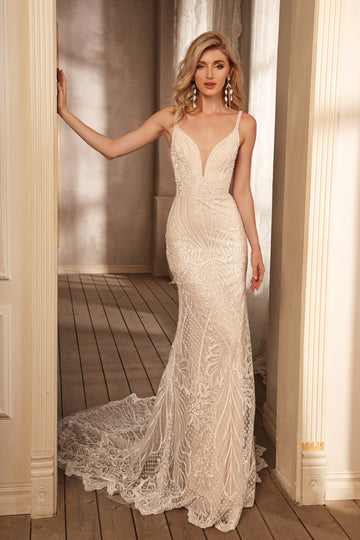Understanding Wedding Dress Terminology: A Comprehensive Guide
Understanding Wedding Dress Terminology: A Comprehensive Guide
Decoding the Language of Bridal Attire
As brides embark on the enchanting journey of wedding planning, one of the most pivotal elements they encounter is the wedding dress. However, with a plethora of styles, fabrics, and terms, many find themselves confused by the intricate terminology associated with bridal attire. In this guide, we will demystify wedding dress terminology, offering clarity that will empower brides to make informed decisions in their pursuit of the perfect gown.
The Basics of Wedding Dress Terminology
Before diving deeper, let’s establish a foundational understanding of essential wedding dress terminology. Whether you’re trying on dresses or discussing your vision with a designer, familiarity with these terms can enhance your experience. Below is a table summarizing common terms:
| Term | Definition |
| A-Line | A silhouette that is fitted at the bodice and gradually flares out towards the hem, resembling the shape of the letter "A." |
| Ball Gown | This style features a fitted bodice and a full, voluminous skirt, typically adorned with tulle or organza. |
| Mermaid | A form-fitting dress that flares out at the knee, enhancing the bride's curves. |
| Train | The portion of the dress that extends behind the bride, adding elegance to her walk down the aisle. |
| Chapel Train | A shorter train that extends about 3 to 4 feet behind the dress. |
| Sweetheart Neckline | A neckline that is shaped like the top half of a heart, flattering for brides with various body types. |
| Lace | A delicate fabric often used in wedding dresses, known for its intricate patterns. |
Understanding Dress Silhouettes
Dress silhouettes are crucial in determining how a gown will fit and fall on the body. Knowing the different silhouettes can help brides find the style that flatters their figure the most. Here are descriptions of some popular silhouettes:
A-Line
This silhouette is universally flattering and ideal for almost all body types. It draws attention to the waist while allowing for a flowy skirt that provides comfort and elegance. Brides looking for a romantic look often choose A-line dresses.
Ball Gown
The quintessential fairy-tale wedding dress, the ball gown features a fitted bodice and a voluminous skirt. Perfect for formal weddings, this style allows for dramatic movement, making it a favorite for many brides.
Mermaid
Enhancing the bride’s silhouette, the mermaid gown hugs the body closely and flares out at the knees, emphasizing curves. This style exudes confidence and sophistication, suitable for a modern bride.
Fabrics and Materials
The choice of fabric is just as essential as the style of the dress. Different fabrics can dramatically alter the look and feel of the gown. Here are some popular options:
Silk
A luxurious fabric that drapes beautifully, silk is often used in high-end wedding gowns, offering a soft and smooth finish.
Tulle
This lightweight, netting-like fabric is often used for skirts or overlays, creating a whimsical effect. It is a perfect choice for brides who want a voluminous ball gown.
Lace
As mentioned earlier, lace adds a vintage or romantic touch to wedding dresses. It is commonly used for overlays, sleeves, or inserts.

Customization: Alterations and Accessories
Brides often choose to customize their gowns through alterations and accessories. Alterations may include adjusting the length of the hem, taking in seams, or changing neckline styles. Accessories can range from veils and belts to jewelry and shoes, all of which can enhance the overall look of the dress.
Bridal Terminology FAQs
Many brides have similar questions when it comes to wedding dress terminology. Here are some frequently asked questions to help guide you in your search:
What is the difference between a wedding dress and a bridal gown?
Generally, the terms "wedding dress" and "bridal gown" are interchangeable. However, "bridal gown" may refer specifically to the design and formality of the dress, while “wedding dress” can encompass a broader range of styles.
What are the advantages of shopping early?
Shopping early allows brides ample time for fittings, alterations, and customizations. It also reduces the stress of last-minute decisions, ensuring the bride can focus on other aspects of wedding planning.
How do I determine my dress size?
Wedding dress sizes can vary significantly from regular clothing sizes. It’s vital to get measured by a professional at a bridal shop to find the most accurate size for your gown.
Creating Your Vision
When it comes to wedding dress shopping, visual inspiration often plays a key role in shaping your decisions. Creating a vision board using fabrics, styles, and terminologies that resonate with you can streamline your search. Utilize platforms like Pinterest where you can save images of your favorite styles and make notes on the terminology associated with each piece.
Conclusion: The Importance of Understanding Wedding Dress Terminology
Understanding wedding dress terminology empowers brides to navigate the exciting yet complex world of bridal fashion with confidence. Whether you’re discussing styles with a designer or communicating your vision to friends and family, familiarizing yourself with these terms can enhance your shopping experience. Remember that the journey to finding your wedding dress should be enjoyable and reflective of your personality. Take your time, explore different styles, and, most importantly, choose a gown that makes you feel beautiful on your special day.
As you embark on this beautiful journey, keep in mind the importance of patience and clarity. Don't hesitate to ask questions when unsure, and always trust your instincts as you select the gown of your dreams.
